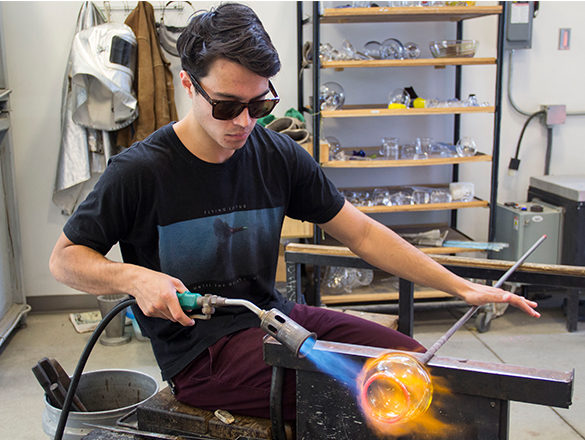
Just as the glass appeared to harden, Alex Dils dipped it into a nearby oven before returning to his workbench. As he carefully pressed metal tools to the side of his newly formed genie vase, the Robin Williams tribute piece shattered into cobalt-shaded fragments.
But Dils didn’t look shattered at the loss.
“When I’m trying new things it’s not about what you can make, it’s about what you can keep,” he said.
It’s not uncommon for glass to break during the glassblowing process, so Dils says you just can’t get too attached to each individual piece.
The artist is new to glassblowing. Entering Ball State as a business major, Dils was inspired to go into art by another student during one of his economics lectures. As he was drawing pictures of the professor, he caught the student’s attention.
“Dude, what are you doing in here?” the student asked.
“That’s a good question,” Dils said. “I don’t know.”
The next day he went to the art department office and transferred, without any previous art classes. What might have seemed like a crazy move felt like a perfect fit to Dils.
“There’s something about glassblowing that’s insane and you have to be a little bit insane to try it, so I like that aspect,” Dils said. “I like that if you meet another person who’s a glassblower they’re probably just as crazy as you are.”
The heat is the biggest thing to overcome, he said. Panic immediately sets in as soon as the heat surrounds him. Unlike other glassblowing skills that develop with time and practice, the 900-degree heat is an uncomfortable aspect that you just have to deal with.
“The second that door opens you forget everything that you just watched someone demo. It’s like flailing with some lava at the end of a pipe,” Dils said.
Now with over two and a half years of glassblowing experience, he doesn’t panic as often.
“I get the panic when I’m working with something a lot bigger. That heat gets a lot closer to your arms so you have a higher chance of probably getting burnt,” he said.
As an artist, he said he can’t be afraid of two aspects of glassblowing: getting burnt and failing.
He typically puts in 15 to 20 hours per week working in the studio. He sometimes come in as early as 7 a.m. and stays until around midnight, with an additional two hours of cold cutting, putting the final details on a piece and smoothing out the jagged edges.
During his first semester of glassblowing, Dils became frustrated when he couldn’t get the translucent color he wanted in his coral reef vases. He observed experienced students and professors dealing with the same frustrations and it gave him confidence and inspiration.
“Be open to the fact that sometimes it’s just not going to happen and you’re going to have to learn again and restart,” he said. “Which is hard for some people, but I think it’s a good lesson to learn in life.”
He often gets requests from friends and family for an original piece.When he’s able to give a piece to a loved one, the hard work is worth it.
“You’ve captured a moment of time, of frustration, of learning, of sweat, of getting burnt,” he said. “You’re capturing that moment in a piece and you get to share it with somebody, which is really awesome. Each piece tells a story.”




